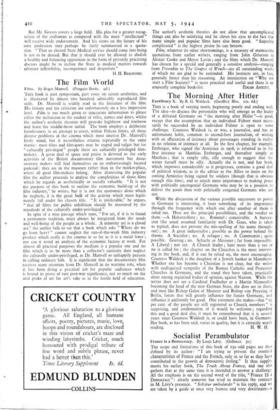The Film World
Film. By Roger Manvell. (Penguin Books. gd.)
Tins book is part symposium, part essay on screen aesthetics, and is illustrated by almost two hundred admirably reproduced film stills. Dr. Manvell is widely read in the literature of the film. His history and his criticism are unfortunately on a less impressive level. Film is too much given to inaccurate information to please either the technician or the student of titles, names and dates, whilst the author's aesthetic theories will provoke highbrow and lowbrow and leave the middle-brow unfed. The book employs a deliberate formlessness in an attempt to cover, within Pelican limits, all those diverse problems of the cinema which most interest Dr. Manvell's lively mind, but it nevertheless returns repeatedly to the same theme: most films and film-goers may be stupid and vulgar but for "culturally privileged" people there are culturally privileged film- makers. A great deal of space and praise is devoted to the early activities of the British documentary film movement but docu- mentary makers will find themselves on an embarrassingly located pedestal: they are in the museum rather than in the market-place, where all good film-makers belong. After dismissing the popular film the author proceeds to analyse the complexities of those films which he regards as aesthetically or socially valuable. "It is not the purpose of this book to outline the economic build-up of the film industry," he writes, but it is not the economics alone which he neglects, it is the great bulk of the activity which must legiti- mately fall under his chosen title. "It is intolerable," he argues, "that all films for public exhibition should be measured by the standards of the culturally under-privileged."
In spite of a wise passage which runs, "For art, if it is to found a permanent tradition, must always be integrated from the needs and well-being of the people as a whole. A minority art is a closed art," the author fails to see that a book which asks "Where do we go from here?" cannot neglect the run-of-the-week film industry product which really is the cinema in so far as it is a social force ; nor can it avoid an analysis of the economic factors at work. For almost all practical purposes the medium is a popular one and no film which is to be more than a collector's curiosity dare neglect the culturally under-privileged, as Dr. Manvell so unhappily persists in calling ordinary folk. It is significant that the documentary film receives scant attention from Dr. Manvell in its wartime role, when it has been doing a practical job for popular audiences which is bound to prove of vast post-war significance, not so much on the arid peaks of art for art's sake as in the fertile held of education.
The author's aesthetic theories do not allow that uncomplicated things can also be satisfying and he closes his eyes to the fact that many simple and popular films have also been good. "Superbly complicated" is the highest praise he can bestow.
Film, whatever its other shortcomings, is a treasury of memorable quotations from earlier writers, ranging from John Grierson to Alistair Cooke and Meyer Levin ; and the films which Dr. Manvell has chosen for a special and generally a sensitive analysis—ranging from Potemkin to The Grapes of Wrath—are all outstanding works of which we are glad to be reminded. His instincts are, in fact, generally better than his reasoning. An interjection on "Why not start a Film Society?" is most practical and useful and there is an






















 Previous page
Previous page